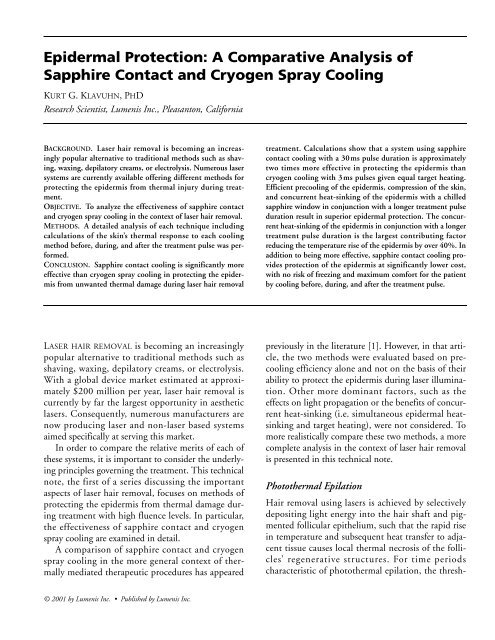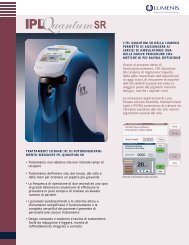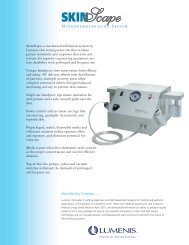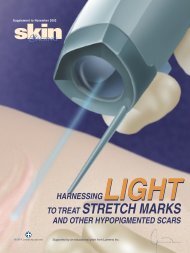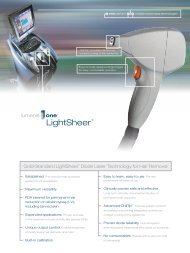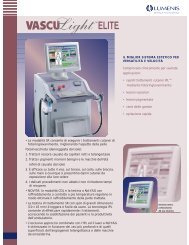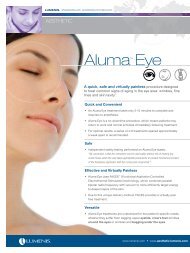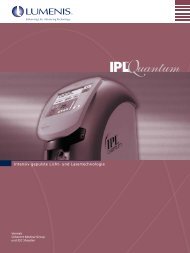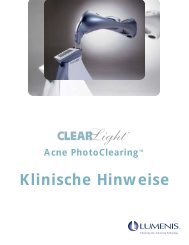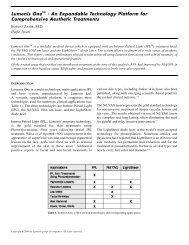Epidermal Protection - Lumenis Aesthetic
Epidermal Protection - Lumenis Aesthetic
Epidermal Protection - Lumenis Aesthetic
You also want an ePaper? Increase the reach of your titles
YUMPU automatically turns print PDFs into web optimized ePapers that Google loves.
<strong>Epidermal</strong> <strong>Protection</strong>: A Comparative Analysis of<br />
Sapphire Contact and Cryogen Spray Cooling<br />
KURT G. KLAVUHN, PHD<br />
Research Scientist, <strong>Lumenis</strong> Inc., Pleasanton, California<br />
BACKGROUND. Laser hair removal is becoming an increasingly<br />
popular alternative to traditional methods such as shaving,<br />
waxing, depilatory creams, or electrolysis. Numerous laser<br />
systems are currently available offering different methods for<br />
protecting the epidermis from thermal injury during treatment.<br />
OBJECTIVE. To analyze the effectiveness of sapphire contact<br />
and cryogen spray cooling in the context of laser hair removal.<br />
METHODS. A detailed analysis of each technique including<br />
calculations of the skin’s thermal response to each cooling<br />
method before, during, and after the treatment pulse was performed.<br />
CONCLUSION. Sapphire contact cooling is significantly more<br />
effective than cryogen spray cooling in protecting the epidermis<br />
from unwanted thermal damage during laser hair removal<br />
treatment. Calculations show that a system using sapphire<br />
contact cooling with a 30ms pulse duration is approximately<br />
two times more effective in protecting the epidermis than<br />
cryogen cooling with 3ms pulses given equal target heating.<br />
Efficient precooling of the epidermis, compression of the skin,<br />
and concurrent heat-sinking of the epidermis with a chilled<br />
sapphire window in conjunction with a longer treatment pulse<br />
duration result in superior epidermal protection. The concurrent<br />
heat-sinking of the epidermis in conjunction with a longer<br />
treatment pulse duration is the largest contributing factor<br />
reducing the temperature rise of the epidermis by over 40%. In<br />
addition to being more effective, sapphire contact cooling provides<br />
protection of the epidermis at significantly lower cost,<br />
with no risk of freezing and maximum comfort for the patient<br />
by cooling before, during, and after the treatment pulse.<br />
LASER HAIR REMOVAL is becoming an increasingly<br />
popular alternative to traditional methods such as<br />
shaving, waxing, depilatory creams, or electrolysis.<br />
With a global device market estimated at approximately<br />
$200 million per year, laser hair removal is<br />
currently by far the largest opportunity in aesthetic<br />
lasers. Consequently, numerous manufacturers are<br />
now producing laser and non-laser based systems<br />
aimed specifically at serving this market.<br />
In order to compare the relative merits of each of<br />
these systems, it is important to consider the underlying<br />
principles governing the treatment. This technical<br />
note, the first of a series discussing the important<br />
aspects of laser hair removal, focuses on methods of<br />
protecting the epidermis from thermal damage during<br />
treatment with high fluence levels. In particular,<br />
the effectiveness of sapphire contact and cryogen<br />
spray cooling are examined in detail.<br />
A comparison of sapphire contact and cryogen<br />
spray cooling in the more general context of thermally<br />
mediated therapeutic procedures has appeared<br />
previously in the literature [1]. However, in that article,<br />
the two methods were evaluated based on precooling<br />
efficiency alone and not on the basis of their<br />
ability to protect the epidermis during laser illumination.<br />
Other more dominant factors, such as the<br />
effects on light propagation or the benefits of concurrent<br />
heat-sinking (i.e. simultaneous epidermal heatsinking<br />
and target heating), were not considered. To<br />
more realistically compare these two methods, a more<br />
complete analysis in the context of laser hair removal<br />
is presented in this technical note.<br />
Photothermal Epilation<br />
Hair removal using lasers is achieved by selectively<br />
depositing light energy into the hair shaft and pigmented<br />
follicular epithelium, such that the rapid rise<br />
in temperature and subsequent heat transfer to adjacent<br />
tissue causes local thermal necrosis of the follicles’<br />
regenerative structures. For time periods<br />
characteristic of photothermal epilation, the thresh-<br />
© 2001 by <strong>Lumenis</strong> Inc. • Published by <strong>Lumenis</strong> Inc.
2 KLAVUHN:EPIDERMAL PROTECTION Laser Hair Removal Technical Note No. 1: January 2000<br />
old temperature for thermal necrosis is on the order<br />
of 70ºC [2]. The selective deposition of energy is<br />
accomplished by illuminating the treatment area with<br />
sufficient fluence (energy per unit area) at a wavelength<br />
that is preferentially absorbed by the endogenous<br />
melanin of the target hair shaft and pigmented<br />
follicular epithelium, but not by the surrounding tissue.<br />
In order to localize the thermal effects, the fluence<br />
is typically delivered within a time less than or<br />
comparable to the thermal relaxation time of the target<br />
structure. The process of selective absorption<br />
leading to local thermal necrosis is known as selective<br />
photothermolysis [3].<br />
<strong>Epidermal</strong> Preservation<br />
As one might expect, the effectiveness of the treatment<br />
(i.e. the percentage of follicles permanently<br />
damaged) scales with the amount of fluence used. In<br />
a study of 92 patients (45 males and 47 females of<br />
varying hair color and skin type) treated with a<br />
<strong>Lumenis</strong> LightSheer Diode Laser System at the<br />
Massachusetts General Hospital in Boston and the<br />
Laser and Skin Surgery Center of New York in New<br />
York City, 32.5% hair reduction was observed at 12<br />
months following a single treatment using a fluence<br />
of 40J/cm 2 and a pulsewidth of 20ms, while 25.9%<br />
was observed for settings of 20J/cm 2 and 10ms [4].<br />
Interestingly, multiple pulses (3×) using the same fluence<br />
levels did not produce measurably better results.<br />
These results indicate that the higher the peak temperature<br />
reached by the target structures, the more<br />
effective the treatment.<br />
Unfortunately, because of the unavoidable absorption<br />
of some of the energy by the melanin in the epidermis,<br />
the maximum amount of fluence (for a given<br />
pulse duration) that can be safely used is limited by<br />
the onset of collateral tissue damage caused by the<br />
heating of the epidermis. Thermal damage to the epidermis<br />
can result in blistering or irregularities in pigmentation.<br />
Although almost invariably (but not<br />
necessarily) temporary, such side effects are nonetheless<br />
undesirable. Therefore, in order to achieve effective<br />
heating of the target hair shafts and follicles while<br />
avoiding thermal damage to the epidermis, it is critical<br />
to optimize the device design and the treatment<br />
procedure to minimize the heating of the epidermis.<br />
Optimization for epidermal preservation without<br />
compromising hair reduction results requires close<br />
examination of the principles governing laser-tissue<br />
interaction. Given a uniform incident beam, the peak<br />
temperature T f (ºC), experienced by absorptive tissue<br />
at depth z (cm), irradiated with incident fluence rate<br />
ψ 0 (W/cm 2 ), is approximated by,<br />
T f<br />
≅ µ aτ p ψ 0<br />
fz ( )<br />
------------------------- 1 e τ p τ r<br />
⎛ –<br />
---------------------- ⎞ + T<br />
ρC ⎝ ⁄ ⎠ i<br />
, (1)<br />
where µ a (cm -1 ) is the absorption coefficient of the<br />
tissue, τ p (s) is the laser pulse duration, f(z) represents<br />
thedependenceofthefluencerateondepth,ρ (g/<br />
cm 3 ) is the tissue density, C (J/g•°C) is the specific<br />
heat of the tissue, τ r (s) is the thermal relaxation time<br />
of the tissue, and T i (ºC) is the initial temperature of<br />
the tissue.<br />
Examination of Eq. (1) reveals that for a given skin<br />
type, determined by µ a , and incident fluence τ p ψ 0 (J/<br />
cm 2 ), epidermal preservation can best be effected by:<br />
precooling the epidermis to lower its initial temperature,<br />
heat-sinking the epidermis during the laser pulse to<br />
effectively shorten its thermal relaxation time, and<br />
using longer pulse durations to allow the heat generated<br />
within the epidermis to dissipate.<br />
Although it is not obvious from Eq. (1), by<br />
compressing the skin to enable the target structures<br />
to be heated more efficiently,<br />
less incident fluence would be required and the thermal<br />
load on the epidermis would be reduced accordingly.<br />
Each of these aspects and their influence on<br />
system design are discussed briefly below.<br />
Precooling the Epidermis. Precooling the epidermis<br />
lowers its initial temperature, and according to Eq.<br />
(1), reduces its peak temperature by a corresponding<br />
amount. Thus, precooling of the epidermis from<br />
30ºC to 5ºC, for example, would reduce the peak<br />
temperature of the epidermis by 25ºC, given equal<br />
incident fluence and target heating.<br />
Heat-Sinking the Epidermis. Iftheskinisincontact<br />
with an effective heat sink during the treatment pulse,<br />
the increased rate of heat extraction from the epidermis,<br />
in effect, lowers its thermal time constant. Low-<br />
τ p<br />
–<br />
τ r<br />
⁄
Laser Hair Removal Technical Note No. 1: January 2000 KLAVUHN: EPIDERMAL PROTECTION 3<br />
ering the thermal time constant of the epidermis<br />
increases the ratio τ p ⁄ τ r , and the term in parenthesis<br />
in Eq. (1), which represents the effect of heat transfer<br />
during the treatment pulse, will reduce accordingly<br />
resulting in less thermal load on the epidermis.<br />
Using Longer Pulse Durations. In a similar manner,<br />
the ratio τ p ⁄ τ r can be increased by simply administering<br />
the treatment fluence over a longer pulse duration.<br />
Because the larger target follicle structures retain<br />
heat longer than the smaller (or thinner) epidermis,<br />
and because the exposed epidermis can lose heat<br />
faster than an insulated hair follicle, the target follicle<br />
structures will retain more of the energy deposited by<br />
a longer pulse than the epidermis. Thus by using<br />
longer pulses, the target follicle structures can be<br />
brought to the damage threshold temperature while<br />
the overlying epidermis remains minimally affected.<br />
However, in order to most efficiently heat the target<br />
structures while limiting the thermal impact to<br />
the adjacent tissue, it is necessary to deposit the<br />
energy into the target structures within a period of<br />
time less than or comparable to the amount of time it<br />
takes for the heat generated to diffuse out of the target<br />
structures and into the surrounding tissue. The<br />
time it takes for the heat to diffuse is characterized by<br />
the thermal relaxation time, τ f (s), of the target structure,<br />
which is approximated by [5],<br />
τ f ≅ d 2<br />
⁄ kα<br />
, (2)<br />
where α is the thermal diffusivity of the target structure<br />
and its surroundings (approximately<br />
1.1×10 -3 cm 2 /s for tissue [6]), and k is a geometrical<br />
factor (equal to 16 for a long cylinder of diameter d).<br />
The target structures for photothermal epilation are<br />
believed to include the hair shaft, the stem cells of the<br />
bulb and the more superficially located inner and<br />
outer root sheaths surrounding the follicle. The crosssectional<br />
diameter of the bulb, for example, ranges<br />
from 200–300µm [7]. Assuming that the target<br />
includes the tissue within a cylinder of diameter 1.5<br />
times that of the bulb, the laser pulse duration τ p can<br />
safely have a maximum value of 50–100ms in length,<br />
depending on the size of the hair. Note, however, that<br />
as the pulse duration increases, more of the heat dissipates<br />
into the surrounding tissue requiring proportionally<br />
greater fluence to achieve the same peak<br />
target temperature.<br />
Compressing the Skin. Compressing the skin<br />
squeezes the blood out of the treatment area and<br />
forces the hair follicles to lie down bringing the roots<br />
closer to the surface. Blood contains hemoglobin, a<br />
competing chromophore that has an absorption coefficient<br />
of approximately 5cm -1 at 800nm. Assuming<br />
a uniformly distributed 1.0% volume fraction of<br />
blood, squeezing out the blood results in approximately<br />
3–7% greater fluence at the target structures<br />
at a depth of 1–3mm. And, in addition to squeezing<br />
out the blood, the compression of the skin brings the<br />
target structures somewhat closer to the surface where<br />
they are exposed to proportionally higher fluence levels.<br />
Because the fluence level within the skin drops<br />
rapidly with depth, even a small decrease in depth can<br />
result in a relatively large increase (depending on the<br />
initial depth) in fluence. Thus, skin compression<br />
enables the target structures to be heated more efficiently,<br />
so that less fluence is required resulting in less<br />
thermal load on the epidermis.<br />
In summary, by judiciously selecting the laser<br />
pulse duration and actively cooling the epidermis<br />
prior to and heat-sinking the epidermis during the<br />
treatment pulse in a manner that provides compression<br />
of the skin, epidermal damage can be avoided<br />
while administering the highest, most effective fluence<br />
levels.<br />
Analysis of Sapphire Contact and<br />
Cryogen Spray Cooling<br />
As protecting the epidermis is critical to safe and<br />
effective hair removal, commercially available laser<br />
hair removal systems attempt to cool the epidermis<br />
without significantly reducing the temperature of the<br />
target hair shafts and surrounding follicle structures,<br />
which lie at least 1mm below the skin surface. A<br />
number of different strategies are employed including<br />
the application of a refrigerated gel to the skin surface<br />
prior to treatment, the precooling of the skin surface<br />
through contact with a chilled metal plate, the precooling<br />
of the skin through rapid evaporation of a
4 KLAVUHN:EPIDERMAL PROTECTION Laser Hair Removal Technical Note No. 1: January 2000<br />
Epidermis<br />
(~100 µm)<br />
Dermis<br />
(~4 mm)<br />
Cyogen<br />
Spray<br />
Bulb<br />
cryogen spray applied to the skin just prior to the<br />
treatment pulse, the cooling of the skin before, during,<br />
and after the treatment pulse with chilled air or<br />
through contact with a chilled sapphire window. The<br />
following is a detailed comparison of two of these<br />
strategies, cryogen spray cooling (e.g. the Dynamic<br />
Cooling Device used on the Candela ® Gentle-<br />
LASE ® ), and contact cooling via a chilled sapphire<br />
window (e.g. the ChillTip handpiece used on the<br />
<strong>Lumenis</strong> LightSheer Diode Laser System).<br />
Cryogen Spray Cooling<br />
Bulge<br />
Distance<br />
Gauge<br />
Laser<br />
Beam<br />
Hair<br />
Follicle<br />
Sebaceous<br />
Gland<br />
Hair Shaft<br />
Figure 1. A typical cryogen spray cooling device emits a<br />
focused spray of cryogen on the treatment area milliseconds<br />
before each laser pulse.<br />
A typical cryogen spray cooling device is illustrated in<br />
Fig. 1. Such devices typically use HFC-134a (1,1,1,2-<br />
tetrafluoroethane), an odorless, colorless, liquefied<br />
chlorofluorocarbon substitute. It should be noted<br />
that although relatively nontoxic, HFC-134a can<br />
cause central nervous system depression after prolonged<br />
inhalation exposure and, thus, should only be<br />
used in well-ventilated areas [8]. The cryogen spray<br />
cooling device delivers a spurt of HFC-134a to the<br />
treatment area just prior to the treatment pulse. The<br />
duration of the spurt is typically adjustable from 20–<br />
100ms, and the distance from the treatment area is<br />
set by a distance gauge.<br />
Evaporation of the cool liquid cryogen droplets<br />
(Boiling Point=-26.5°C at 1atm) as they impinge the<br />
relatively warm skin surface, rapidly cools the epidermis.<br />
As the skin surface temperature decreases toward<br />
the boiling point of the cryogen, the rate of heat<br />
extraction from the skin is no longer sufficient to<br />
completely evaporate the cryogen droplets and a film<br />
of cryogen droplets and ice (a result of the condensation<br />
of water vapor present in the air) begins to accumulate<br />
on the skin surface. A thin vapor layer<br />
between the cryogen-ice film and the ‘hot’ skin surface<br />
[9,10] protects the epidermis from the severely<br />
low
Laser Hair Removal Technical Note No. 1: January 2000 KLAVUHN: EPIDERMAL PROTECTION 5<br />
Skin Temperature (°C)<br />
35<br />
30<br />
25<br />
20<br />
15<br />
10<br />
5<br />
0<br />
-5<br />
0 µm<br />
60-80 µm Basal Layer<br />
125 µm<br />
200 µm<br />
500 µm<br />
-10<br />
0 25 50 75 100<br />
Spurt Duration (ms)<br />
Skin Temperature (°C)<br />
100<br />
90<br />
80<br />
70<br />
60<br />
50<br />
40<br />
30<br />
20<br />
10<br />
0<br />
-10<br />
60-80 µm Basal Layer<br />
0 µm Skin Surface<br />
50 ms<br />
Crogen Spurt<br />
20 ms<br />
Delay<br />
3ms<br />
Laser Pulse<br />
Damage Threshold<br />
-20<br />
0 25 50 75 100 125 150<br />
Time (ms)<br />
Figure 2. Skin temperature at various depths in response<br />
to cryogenic spray cooling of durations up to 100ms [11].<br />
The 60–80µm basal layer is indicated by the shaded band.<br />
Figure 3. Skin temperature response to a 20J/cm 2 ,755nm<br />
treatment pulse with a pulse duration of 3ms after a 50ms<br />
cryogen spurt and 20ms delay [15]. The 60–80µm basal<br />
layer is indicated by the shaded band.<br />
gen spray cooling. This layer has been measured to be<br />
up to 20µm thick for a spurt duration of 80ms [12]<br />
and is capable of attenuating the incident fluence by<br />
as much as 30–35% (λ=755nm)[13]. The attenuation<br />
is largely a result of the backward scattering of<br />
the incident beam from the exposed treatment area.<br />
The beam scattering and accompanying beam attenuation<br />
can be avoided by either eliminating the ice formation<br />
through reduction of the local relative<br />
humidity to 5% or below [14], or by delaying the<br />
laser pulse until the film evaporates.<br />
Measurements have shown that the evaporation<br />
time for the ice layer can be as much as 100–300ms<br />
for typical relative humidity levels of 30–60% [14].<br />
Although the ice film acts as a heat sink maintaining<br />
the skin surface at 0°C or below until it evaporates,<br />
the amount of delay required for evaporation of the<br />
film is uncertain. Minor miscalculations in the delay<br />
can lead to significant temperature recovery in the<br />
epidermis prior to the treatment pulse.<br />
Computed Thermal Response. Fig. 3 shows the calculated<br />
response of the skin temperature to a 755nm<br />
treatment pulse (3ms pulse duration, fluence of 20J/<br />
cm 2 ) following cryogen spray cooling (50ms spurt<br />
duration, 20ms delay). The effects of cryogen-ice<br />
film formation have been neglected, and for simplicity,<br />
the epidermal melanin has been assumed to be<br />
uniformly distributed throughout the epidermis. As<br />
can be seen, the 50ms cryogen spurt cools the skin<br />
surfaceto6ºCandthe60µm deepbasallayerto<br />
18ºC. However, during the subsequent 20ms delay,<br />
the skin surface temperature recovers to 16ºC in<br />
20ºC air. As the laser irradiates the treatment area,<br />
the relatively low 20J/cm 2 fluence heats both the surface<br />
of the skin and the 60µm deep basal layer to<br />
approximately 70ºC.<br />
This relatively high epidermal temperature results<br />
from a number of factors, including the short (essentially<br />
adiabatic) pulse duration, lack of heat-sinking<br />
during the pulse, and the delay required to allow<br />
clearance of the cryogen. Because cryogen spray cooling<br />
does not provide significant heat-sinking and the<br />
heat transfer into the adjacent air is relatively poor,<br />
the heat generated in the epidermis by the relatively<br />
short 3ms pulse does not have a chance to dissipate<br />
into the surrounding tissue or air. And although relatively<br />
short, the 20ms delay enables the skin surface<br />
temperature to recover by approximately 42%. In
6 KLAVUHN:EPIDERMAL PROTECTION Laser Hair Removal Technical Note No. 1: January 2000<br />
Epidermis<br />
(~100 µm)<br />
Dermis<br />
(~4 mm)<br />
Bulb<br />
Laser<br />
Beam<br />
addition, the lack of active cooling during and after<br />
the laser pulse prolongs the time for the skin to return<br />
to its normal temperature, thereby increasing patient<br />
discomfort.<br />
Cost. The cryogen spray and disposable distance<br />
gauges are consumables and contribute significantly<br />
to the operating cost of a system using cryogen spray<br />
cooling. For example, assuming an average cost per<br />
spurt of $0.01–0.03, a high-volume practice using<br />
500,000–1,500,000 pulses per year would incur<br />
annual operating costs of approximately $5,000–<br />
$45,000 for cryogen spray alone.<br />
Sapphire Contact Cooling<br />
Bulge<br />
Cooled<br />
Sapphire<br />
Window<br />
Sebaceous<br />
Gland<br />
Hair Shaft<br />
Hair<br />
Follicle<br />
Figure 4. A typical sapphire contact cooling device lowers<br />
the epidermal temperature through contact with its<br />
actively cooled sapphire window. Pressing the window<br />
onto the skin creates good thermal contact while squeezing<br />
out the blood and bringing the hair follicles closer to<br />
the skin surface and into areas of higher fluence.<br />
A typical sapphire contact cooling arrangement is<br />
illustrated in Fig. 4. A 5°C liquid-cooled sapphire<br />
window at the tip of the handpiece is pressed against<br />
the patient’s skin for approximately 250ms prior to<br />
initiating the treatment pulse. Because the sapphire<br />
window is above freezing, there is no risk of skin<br />
damage as a result of overcooling. Moreover, there is<br />
no ice formation on the skin surface and the treatment<br />
fluence is most effectively coupled into the skin.<br />
Results from a simple one-dimensional heat transfer<br />
analysis of sapphire contact cooling are shown in<br />
Fig. 5. The results indicate that the surface of the epidermis<br />
is cooled to approximately 9°C during the initial<br />
250ms of contact with the chilled sapphire, while<br />
the more vulnerable basal layer at a depth of approximately<br />
60–80µm (depending on the thickness of the<br />
epidermis) is cooled to 13–15°C, a temperature comparable<br />
to that achieved with a 50ms cryogen spurt.<br />
As with the cryogen spray cooling, the temperatures<br />
of the important targets at depths of greater than<br />
1mm remain essentially unchanged even for contact<br />
times of up to 1 second. And although in practice it is<br />
difficult to precisely judge a contact time of 250ms,<br />
Fig. 5 shows that for the depths of interest,<br />
0≤z≤80µm, little variation in the skin temperature<br />
results for contact periods as short as 100ms or as<br />
long as 1 second.<br />
Skin Compression. Thepressureofthesapphirewindow<br />
against the skin not only provides excellent thermal<br />
contact and optical coupling of the laser pulse<br />
into the tissue, but also squeezes out the blood and<br />
forces the hair follicles to lie down bringing the roots<br />
closer to the surface. As discussed earlier, compression<br />
of the skin results in approximately 3–7% greater fluence<br />
at the target structures at a depth of 1–3mm as a<br />
Skin Temperature (°C)<br />
35<br />
30<br />
25<br />
20<br />
15<br />
10<br />
5<br />
0 µm<br />
60-80 µm<br />
100 µm<br />
Basal Layer<br />
200 µm<br />
500 µm<br />
1000 µm<br />
0<br />
0 250 500 750 1000<br />
Contact Duration (ms)<br />
Figure 5. Isothermal contours in response to contact cooling<br />
with a sapphire window with constant temperature of<br />
5°C [16]. The 60–80µm basal layer is indicated by the<br />
shaded band.
Laser Hair Removal Technical Note No. 1: January 2000 KLAVUHN: EPIDERMAL PROTECTION 7<br />
Skin Temperature (°C)<br />
90<br />
80<br />
70<br />
60<br />
50<br />
40<br />
30<br />
20<br />
10<br />
0<br />
Damage Threshold<br />
60-80 µm Basal Layer<br />
0 µm Skin Surface<br />
30 ms<br />
Laser Pulse<br />
250 ms Pre-Cooling Concurrent Heat-Sinking<br />
-10<br />
0 100 200 300 400 500<br />
Time (ms)<br />
Figure 6. Skin temperature response to a 800nm treatment<br />
pulse (30ms pulse duration, fluence of 24J/cm 2 ) with concurrent<br />
sapphire contact heat-sinking following 250ms of<br />
precooling [17]. With this fluence, the target hair shaft and<br />
follicle are heated to the same peak temperature as the<br />
treatment pulse (20J/cm 2 , 3ms, 755nm) of the cryogen<br />
cooled system of Fig. 3. Note the much lower epidermal<br />
heating. The 60–80µm basal layer is indicated by the<br />
shaded band.<br />
result of blood dispersal and brings the target structures<br />
somewhat closer to the surface where they are<br />
exposed to proportionally higher fluence levels. These<br />
gains in efficiency enable less fluence to be used for<br />
the same level of efficacy, thereby decreasing the thermal<br />
load on the epidermis.<br />
Computed Thermal Response. Fig. 6 shows the calculated<br />
response of the skin temperature to a 800nm<br />
treatment pulse (30ms pulse duration, fluence of<br />
24J/cm 2 ) with concurrent sapphire contact heatsinking<br />
following 250ms of precooling. As in the previous<br />
calculation for cryogen spray cooling, the epidermal<br />
melanin has been assumed to be uniformly<br />
distributed throughout the epidermis. With this fluence,<br />
the target hair shaft and follicle are heated to<br />
the same peak temperature as the 20J/cm 2 ,3ms,<br />
755nm treatment pulse of the cryogen-cooled system.<br />
The extra energy accounts for the lower melanin<br />
absorption coefficient at 800nm and the greater fluence<br />
required by the longer pulse duration which is<br />
offset, in part, by an improvement in efficiency attributable<br />
to skin compression.<br />
During the precooling period, the 5ºC sapphire<br />
cools the surface of the skin from 30ºC to 9ºC.<br />
Unlike cryogen spray cooling, the sapphire continues<br />
to cool the surface of the skin and, as a result of its<br />
relatively high thermal conductivity, acts as an efficient<br />
heat sink during the laser pulse. As can be seen,<br />
the relatively long pulse duration enables the dissipation<br />
of a significant amount of heat into the sapphire<br />
and neighboring tissue keeping the entire epidermis<br />
well below the damage threshold. Moreover, continued<br />
cooling after the laser pulse increases the rate at<br />
which the skin returns to its normal temperature,<br />
resulting in increased comfort for the patient.<br />
Cost. Because the sapphire window is an integral part<br />
of the light delivery system and does not use any consumables,<br />
there are no additional operating costs<br />
associated with this cooling method.<br />
Conclusions<br />
Sapphire contact cooling is significantly more effective<br />
than cryogen spray cooling in protecting the epidermis<br />
from unwanted thermal damage during laser<br />
hair removal treatment. Calculations show that a system<br />
using sapphire contact cooling with a 30ms pulse<br />
duration is approximately twice as effective in protecting<br />
the epidermis than cryogen cooling with 3ms<br />
pulses given equal target heating.<br />
Efficient precooling of the epidermis, compression<br />
of the skin, and concurrent heat-sinking of the epidermis<br />
with a chilled sapphire window in conjunction<br />
with a longer treatment pulse duration result in<br />
superior epidermal protection. The concurrent heatsinking<br />
of the epidermis in conjunction with a longer<br />
treatment pulse duration is the largest contributing<br />
factor reducing the temperature rise of the epidermis<br />
by over 40%. In addition to being more effective,<br />
sapphire contact cooling provides protection of the<br />
epidermis at significantly lower cost, with no risk of<br />
freezing and maximum comfort for the patient by<br />
cooling before, during, and after the treatment pulse.
8 KLAVUHN:EPIDERMAL PROTECTION Laser Hair Removal Technical Note No. 1: January 2000<br />
References<br />
1. Anvari B, Milner TE, Tanenbaum BS, Nelson JS. A comparative<br />
study of human skin thermal response to sapphire<br />
contact and cryogen spray cooling. IEEE Trans Biomed Eng<br />
1998;45:934-41.<br />
2. Anvari B, Tannenbaum BS, Milner TE, Kimel S, Svaasand<br />
LO, Nelson JS. A theoretical study of the thermal response<br />
of skin to cryogen spray cooling and pulsed laser irradiation:<br />
implications for treatment of port wine stain birthmarks.<br />
Phys Med Biol 1995;40:1451-65.<br />
3. Anderson RR, Parrish JA. Selective photothermolysis: precise<br />
microsurgery by selective absorption of pulsed radiation.<br />
Science 1983;220:524-7.<br />
4.DierickxCC,GrossmanMC,FarinelliBS,CamposVB,<br />
Lin TYD, Manuskiatti W, Anderson RR. Hair removal by<br />
pulsed near-infrared diode laser. Accepted for publication<br />
by Arch Dermatol.<br />
5. Incropera FP, De Witt DP. Fundamentals of Heat and Mass<br />
Transfer. New York: Wiley, 1985.<br />
6. Duck FA. Physical properties of tissue. In: A Comprehensive<br />
Reference Book. London: Academic, 1990.<br />
7. Birbeck M, Mercer E. The electron microscopy of the<br />
human hair follicle. J Biophys and Biochem Cytol<br />
1957;3:203-13.<br />
8. Material Safety Data Sheet, Clickmed Corporation, Gloucester,<br />
MA.<br />
9. Xiong TY, Yuen MC. Evaporation of cryogen droplets on a<br />
hot plate. Int J of Heat and Mass Transfer 1991;34:1881-<br />
1894.<br />
10. Torres JH, Nelson JS, Tanenbaum BS, Milner TE, Goodman<br />
DM, Anvari B. Estimation of internal temperatures in<br />
response to cryogen spray cooling: implications for laser<br />
therapyofportwinestains.IEEE J Selected Topics Quant<br />
Electr 1999;5:1058-66.<br />
11. Calculation assumed T ∞ =-44°C, T i =30°C, h=2.4kW/<br />
m 2 •K, k s =0.45W/m•K, α s =1.1×10 -7 m 2 /s.<br />
12. Anvari B, Milner TE, Tanenbaum BS, Kimel S, Svaasand<br />
LO, Nelson JS. Selective cooling of biological tissues: application<br />
for thermally mediated therapeutic procedures. Phys<br />
Med Biol 1995;40:241-52.<br />
13. Measured attenuation through glass slide as a result of cryogen-ice<br />
film deposited by 80ms spray.<br />
14. Anvari B, Ver Steeg BJ, Milner TE, Tanenbaum BS, Klein<br />
TJ, Gerstner E, Kimel S, Nelson JS. Cryogen spray cooling<br />
of human skin: effects of ambient humidity level, spraying<br />
distance, and cryogen boiling point. SPIE Proc<br />
1997;3192:106-110.<br />
15. Calculation assumed T ∞ =-44°C (t≤80ms), T ∞ =20°C<br />
(t>80ms), h=2.4kW/m 2 •K (t≤80ms), h=20W/m 2 •K<br />
(t>80ms), T i =30°C, k s =0.45W/m•K, α s =1.1×10 -7 m 2 /s,<br />
µ a =3.5cm -1 , µ s =40cm -1 , g=0.8 (0≤z≤80µm),<br />
µ a =0.3cm -1 , µ s =40cm -1 , g=0.8 (z>80µm).<br />
16. Calculation assumed T ∞ =5°C, T i =30°C, h=30kW/m 2 •K,<br />
k s =0.45W/m•K, α s =1.1×10 -7 m 2 /s, k Sa =46W/m•K,<br />
α Sa =1.51×10 -5 m 2 /s.<br />
17. Calculation assumed T ∞ =5°C, T i =30°C, h=30kW/m 2 •K,<br />
k s =0.45 W/m•K, α s =1.1×10 -7 m 2 /s, k Sa =46W/m•K,<br />
α Sa =1.51×10 -5 m 2 /s, µ a =3cm -1 , µ s =40cm -1 , g=0.8<br />
(0≤z≤80µm), µ a =0.3cm -1 , µ s =40cm -1 , g=0.8 (z>80µm).<br />
2400 Condensa Street<br />
Santa Clara, California 95051<br />
Tel: 800-635-1313<br />
408-764-3000<br />
Fax: 800-505-1133<br />
408-764-3999<br />
<strong>Lumenis</strong>, its logo, LightSheer and ChillTip are trademarks of <strong>Lumenis</strong> Inc.<br />
© 2001 by <strong>Lumenis</strong> Inc. Printed in U.S.A. 5337B09015M


